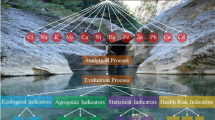Abstract
The Haraz River flows northwards through the Iranian Alborz mountains in the central region of Mazandaran province and empties into the Caspian Sea. This area has been a rich source of minerals from times immemorial. About 45 mines (coal, limestone, sand and gravel, etc.) have been operational for the last eight decades. Towards the estuary, the river receives a discharge of industrial, agricultural and urban wastes. Eight sediment samples from the Haraz River and its main tributaries were collected and analyzed for base metals as well as Sr and Fe. The chemical partitioning of metals (Cu, Zn, As, Cd, Pb, Fe, Ni, Cr, Co and Sr) in each sample was determined in four fractions (acid-soluble, reducible, oxidizable and residual). The total content of each metal was also determined. The results showed relatively higher concentrations of Cd, As, Sr and Pb in comparison to that of shale. However, based on the chemical partitioning of metals, it is found that Pb, Co, Cd and Sr are the most mobile metals. In spite of the high As concentrations in sediments, it is not likely that this element is a major hazard for the aquatic environment, since it is found mainly in the residual fraction. Cadmium is the metal that showed the highest percentages in the acid-soluble fraction (the most labile) and the lowest in the residual fraction. However, Fe, Cr and Ni are present in the greatest percentages in the residual fraction, which implies that these metals are strongly linked to the sediments.







Similar content being viewed by others
References
Baba A, Gungor T (2002) Influence of gold mine on groundwater quality (Efemcukuru, Izmir, Turkey). Environ Geol 41:621–627
Das AK, Chakraborty R, Cervera ML, de la Guardia M (1995) Metal speciation in solid matrices. Talanta 42:1007–1030
Datta DK, Subramanian V (1998) Distribution and fractionation of heavy metals in the surface sediments of the Ganges–Brahmaputra–Meghna river system in the Bengal basin. Environ Geol 36(1–2):93–101
Davis JC (1973) Statistics and data analysis in geology. Wiley International, New York, pp 456–473
Izquierdo C, Usero J, Gracia I (1997) Speciation of heavy metals in sediments from salt marshes on the southern Atlantic coast of Spain. Mar Pollut Bull 34(2):123–128
Jones B, Turki A (1997) Distribution and speciation of heavy metals in surficial sediments from the Tees estuary, northeast England. Mar Pollut Bull 34(10):768–779
Karbassi AR, Amirnezhad R (2004) Geochemistry of heavy metals, sedimentation rate in a bay adjacent to the Caspian Sea. Int J Environ Sci Technol 1(3):191–198
Karbassi AR, Bayati I, Moattar F (2006) Origin, chemical partitioning of heavy metals in riverbed sediments. Int J Environ Sci Technol 3(1):35–42
Karbassi AR, Nouri J, Ayaz GO (2007) Flocculation of trace metals during mixing of Talar River water with Caspian Sea water. Int J Environ Res 1(1):66–73
Kersten M, Forstner U (1991) Speciation of trace elements in sediments. In: Batley GE (ed) Trace element speciation: analytical methods and problems. CRC, Boca Raton, pp 245–317
Kingston HM, Jassie LB (1988) In: Kingston HM, Jassie LB (eds) Introduction to microwave sample preparation. Washington, DC: American Chemical Society. p. 263
Licheng Z, Guijiu Z (1996) The species and geochemical characteristics of heavy metals in the sediments of Kangjiaxi River in the Shuikaushan mine area. China Appl Geochem 11:217–222
Lopez-Sanchez JF, Rubio R, Rauret G (1993) Comparison of two sequential extraction procedures for trace metal partitioning in sediments. Int J Environ Anal Chem 51:113–121
Lopez-Sanchez JF, Rubio R, Samitier C, Rauret G (1996) Trace metal partitioning in marine sediments and sludges deposited off the coast of Barcelona (Spain). Water Res 30(1):153–159
Mehrdadi N, Ghobadi M, Nasrabadi T, Hoveidi H (2006) Evaluating the qualitative condition and self-purification potential of Tajan River using Qual2E model. Iran J Environ Health Sci Eng (IJEHSE) 3(3):199–204
Morillo J, Usero J, Gracia I (2002) Partitioning of metals in sediments from the Odiel River (Spain). Environ Int 28:263–271
Nabi Bidhendi GR, Karbassi AR, Nasrabadi T, Hoveidi H (2007) Influence of copper mine on surface water quality. Int J Sci Technol (IJEST) 4(1):85–91
Rauret G, Rubio R, Lo′pez-Sa′nchez J, Casassas E (1988) Determination and speciation of copper and lead in sediments of a Mediterranean river (River Tenes, Catalonia, Spain). Water Res 22:449–455
Rauret G, Lo′pezSanchez JF, Sauquillo A, Rubio R, Davidson C, Ure A, Quevauviller Ph (1999) Improvement of the BCR three step sequential extraction procedure prior to the certification of new sediment and soil reference materials. J Environ Monit 1:57–61
Summers RW (1980) The diet and feeding behaviour of the flounder Platichthys flesus (L) in the Ythan Estuary, Aberdeenshire, Scotland. Estuar Coast Shelf Sci 2:217–232
Surija B, Branica M (1995) Distribution of Cd, Pb, Cu and Zn in carbonate sediments from the KrKa River estuary obtained by sequential extraction. Sci Total Environ 170:101–118
Turekian KK, Wedepohl KH (1961) Distribution of the elements in some major units of earth’s crust. Bull Geol Soc Am 72:175–192
Weisz M, Polya′k K, Hlavay J (2000) Fractionation of elements in sediment samples collected in rivers and harbors at lake Balaton and its catchment area. Microchem J 67:207–217
Yu K-C, Tsai L-J, Chen S-H, Ho S-T (2001) Correlation analyses binding behavior of heavy metals with sediment matrices. Water Res 35(10):2417–2428
Zoumis T, Schmidt A, Grigorova L, Calmano W (2001) Contaminants in sediments: remobilisation and demobilisation. Sci Total Environ 266:195–202
Acknowledgment
The authors acknowledge the support provided by the Faculty of Environment, University of Tehran and comparative data support by the project (DOE-UTE-WPR-2) of the Department of Environment of Iran.
Author information
Authors and Affiliations
Corresponding author
Rights and permissions
About this article
Cite this article
Nasrabadi, T., Nabi Bidhendi, G., Karbassi, A. et al. Partitioning of metals in sediments of the Haraz River (Southern Caspian Sea basin). Environ Earth Sci 59, 1111–1117 (2010). https://doi.org/10.1007/s12665-009-0101-x
Received:
Accepted:
Published:
Issue Date:
DOI: https://doi.org/10.1007/s12665-009-0101-x




